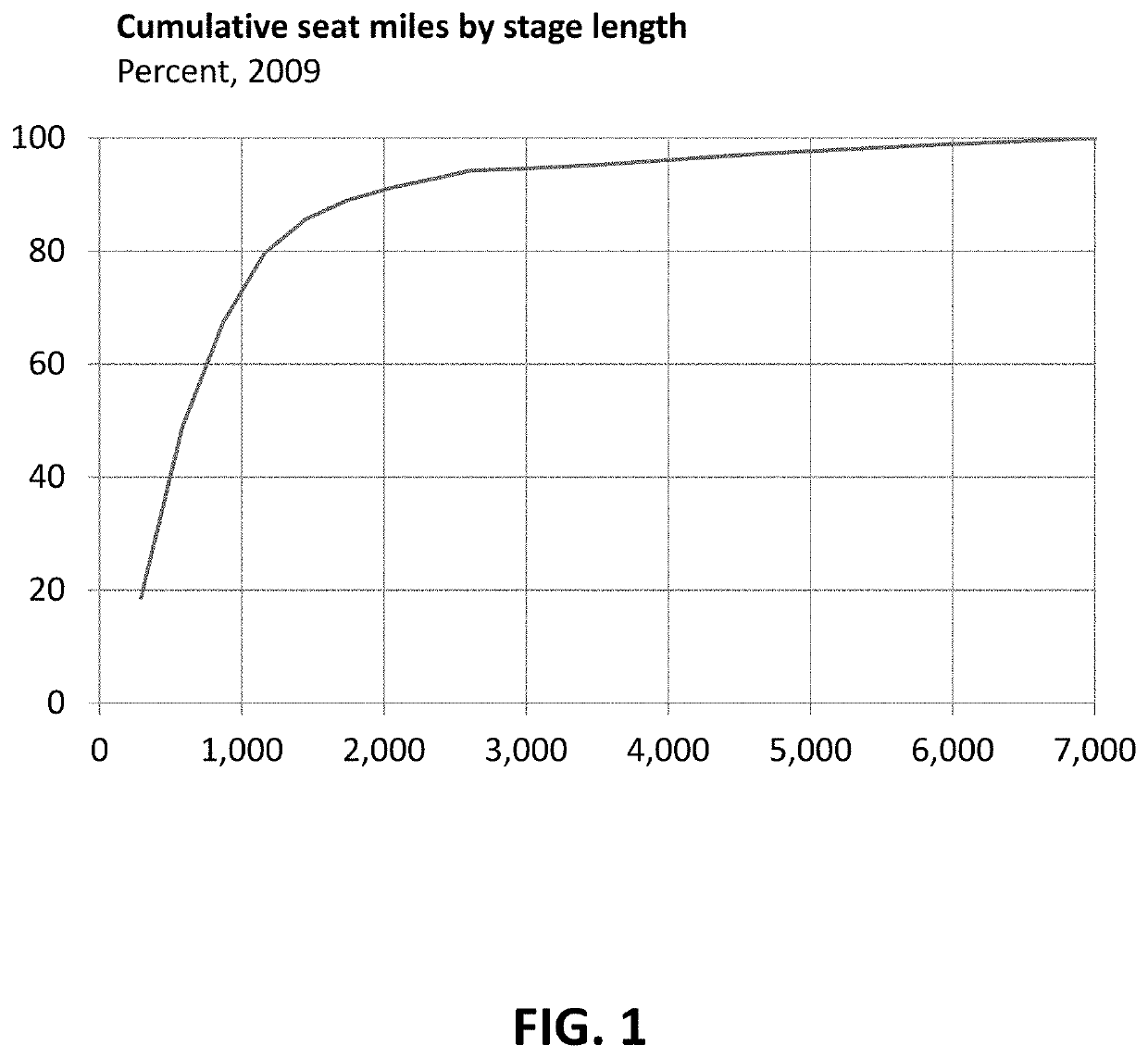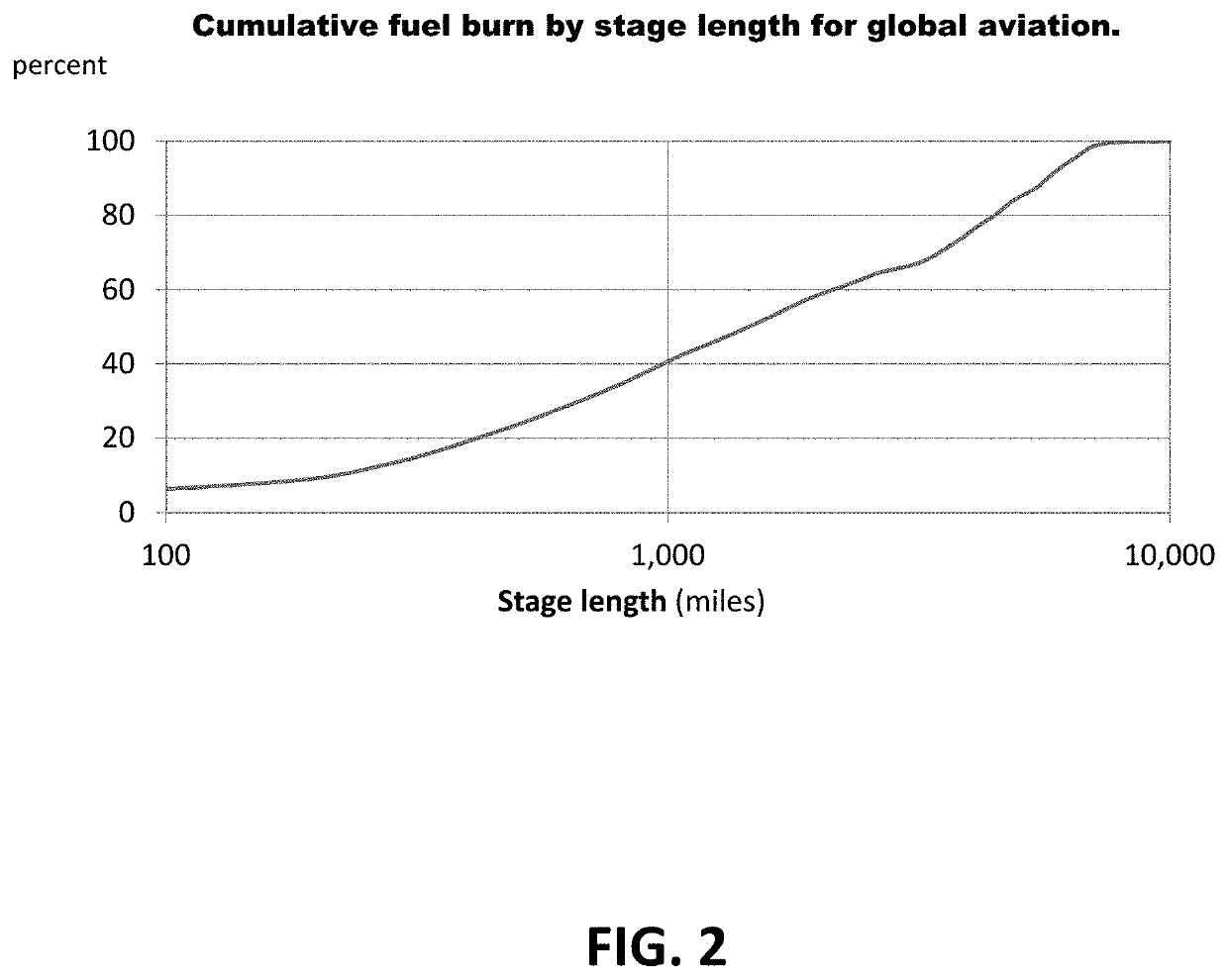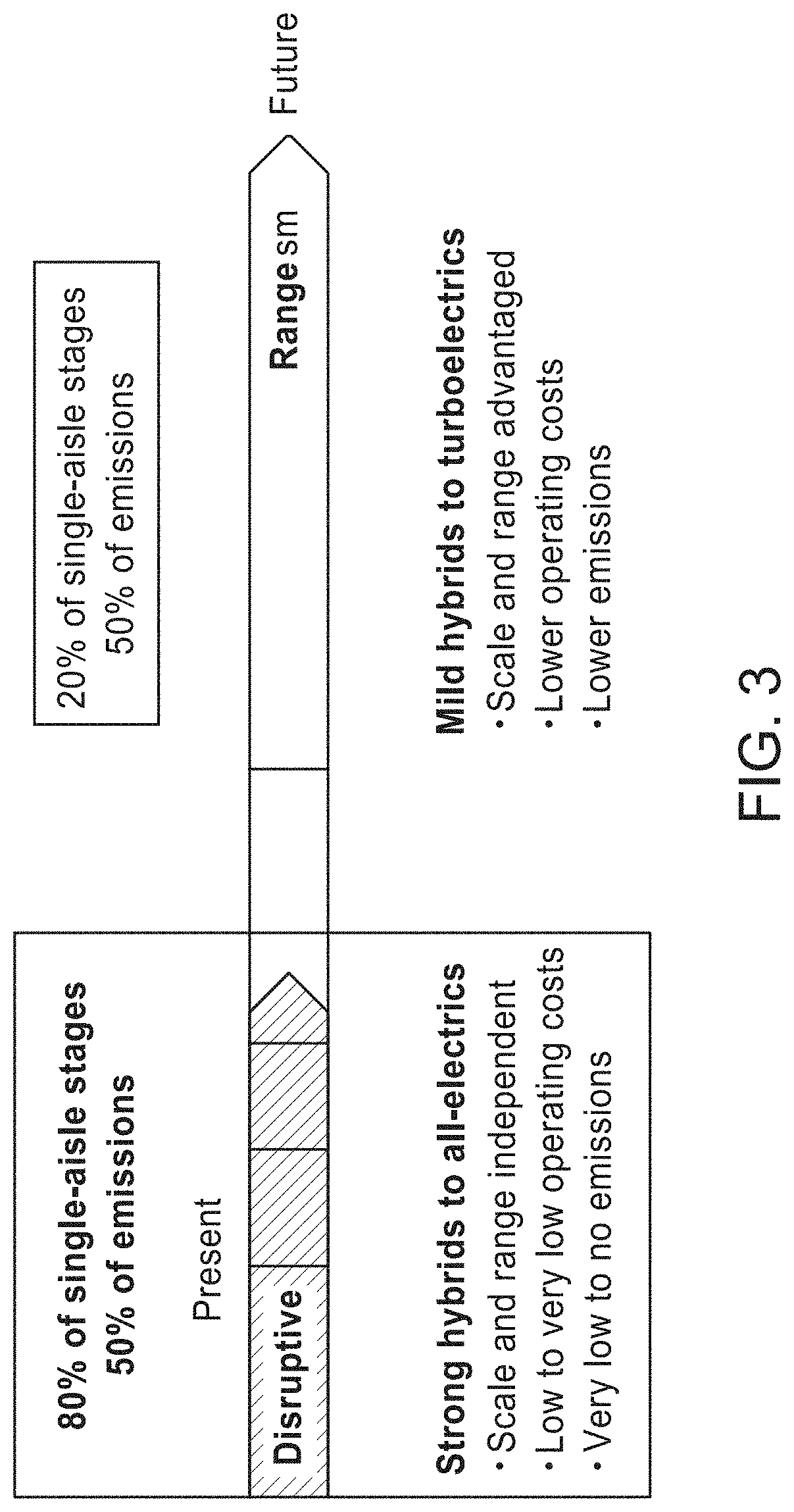The higher maximum take-off weight and
cruise speed requirements given aircraft designed for longer ranges translate to a higher operating empty weight, and in turn, to a higher induced drag and fuel burn.
This non-intuitive result is due to altitude-independent propulsion efficiency of the variable-
pitch electrically-driven ducted fan, and the gas
turbine generation reaching peak efficiency at lower altitudes than a conventional high bypass
turbofan.
However, these pressure ratios are still lower than those for a conventional aircraft, via optimized motor-fan integration at lower rpms with variable pitch.
In yet other inventive implementations, the optimization is constrained by a minimum
cruise speed for range (C), which results in a longer range (i.e., long-haul) aircraft with reduced savings.
This configuration of only four lift points would normally result in a catastrophic loss of control following failure of any one
propulsor.
VTOL aircraft have insufficient aerodynamic lifting surfaces to allow a safe
runway landing without powered lift.
But that is slowly starting to change.
Although the ICAO agreement was widely welcomed as long overdue, the offsetting proposal remains controversial.
Given that innovation lags the rapid growth of the sector, most expect the airlines to meet the bulk of their commitments through offsets “the quickest to implement, the easiest to administer, and the most cost-efficient.”1 Critics fear that any pressure on the sector to decarbonize will be insignificant, and worse still, that the environmental benefit of offsets will be lost in the
opacity and double-counting that bedevils these today.
As a result, shorter range vehicles are electrifying quickly, with immediate
impact on emissions, while the pace of deployment over longer ranges is much slower.
Unfortunately,
aviation today is impeded by conservatism, mirroring the behavior of other sectors when first impacted by
electrification.
Studies have often overestimated what component performance is needed for use on aircraft or underestimated how well state-of-the-art components perform.
The program was halted in the turmoil of the 1973 oil crisis.
In the 2000s, the EU Small Aircraft Transport program identified regional air as key to improved mobility, complementing conventional air and high-speed rail.9 However, all of these were doomed by the lack of cost-competitive propulsion for regional aircraft.
But the basic problem is that there really isn't an economic vehicle that will permit carriers to operate profitably.”10 9 Small Aircraft Transport as a new component of the EU
Air Transport System, SAT Roadmap, 2011.10 Senior Vice President at Citibank, Proceedings of OTA Advanced
Air Transport Advisory Panel, 1980.
The 70-year shift of the airlines to larger aircraft, longer ranges, and a shrinking set of high-volume hubs has created a “transport gap” over regional ranges where there is no real alternative to highways.
High-speed rail, the only other option for fast regional travel, is limited by high infrastructure costs to a few very high-density corridors with passenger volumes large enough to support the investment.
The conservatism is harmful in several ways.
It translates to a delayed and modest response to the
threat of
climate change, forgoes a once-in-a-generation window to leapfrog to leadership in high-speed regional transport and electrified
aviation, and leaves US
aerospace vulnerable to intensifying competition from overseas.
However, the transition of the grid to a largely renewables basis over the timeframe of interest will leave them far behind, creating need for sustainable alternatives.
The recommendation to deprioritize sources of power other than
gas turbines is a barrier to innovation.
So much so that “widespread adoption of battery-powered vehicles is a serious
threat to the oil industry” driving need to prepare for “radical change” given real risk of an “investor death spiral” as capital flees the sector.15 15 Oil groups ‘threatened’ by
electric cars, Financial Times, 2016.
Adoption of ground electric vehicles was impeded by higher costs, but as these approach parity, growth is accelerating.
In contrast, the proposed one-step to single-
aisle turboelectrics, with power levels in the 20 to 25 MW range, is fraught with risk for relatively modest emissions reduction.
As a result, resource levels committed by the
aerospace majors to electrified long-haul airliners remain low, underlining an uncertain future, driven largely by oil prices, regulation and government support.
It is estimated that carbon allowances under EU ETS would need to be priced over 10 times higher “before having any real influence on fleet planning or the acquisition and further development of new aircraft technologies.”19 Moreover, the 2030s entry would
delay climate action by two decades, and forgo the opportunity to defray development costs and risk via electrified regional platforms.
This is inefficient and may also not be in the best interests of society at large, as it translates to
poor mobility (relatively long door-door times), creates
pollution, and puts stress on the existing highway infrastructure.
However, current commercial air services over this range are often relatively costly and inconvenient.
As a result, in such situations, air transportation is generally not a desirable
mode of transport and is currently used for less than 1% of such regional trips.
In contrast, the relatively poor value proposition (and hence usage) of
air travel over regional ranges might be considered a striking failure; even more so, given that almost all (94%) long-distance travel is regional.
In this sense there is a demonstrated need for a desirable form of regional distance air transportation, but a lack of a desirable
system for satisfying that need.
This failure to develop an effective and efficient form of regional air transportation has led to stagnant door-to-door travel times and has been a significant factor in limiting mobility improvements in the United States for several decades.
This is highly undesirable, as
limited mobility impacts business and pleasure travel, job development and opportunities, educational choices, and other factors which are beneficial to the growth and prosperity of society.
Thus, the present economic forces are causing current methods of providing air transportation to move steadily away from the types of systems and methods described herein.
As will be described, conventional approaches to providing
air transport services for regional travel are not sufficiently convenient or effective for purposes of encouraging widespread use by potential customers.
As recognized by the inventors, the failure of modern
aviation services to address the need for regional
air transport is a direct outcome of the use of conventional aircraft technology.
It is well known by those experienced in the art that optimizing conventional aircraft for regional operations results in design and performance compromises which adversely affect efficiency.
For example,
gas turbines (jet and
turboprop engines) suffer a significant decrease in efficiency at lower altitudes and slower speeds, and a further loss of efficiency when scaled to smaller sizes.
In addition, short
runway operations impose a penalty in wing and / or engine
sizing larger than optimal for efficient
cruise performance.
As a result, large aircraft over long-ranges offer the lowest operating costs per passenger-
mile, with rapidly increasing costs for distances <500 miles, and for aircraft seating fewer than 100 passengers (or an equivalent cargo weight of 25,000 lbs).
Note that given a relatively poor efficiency on the ground or in climbing mode, scaled down
gas turbines cost more to operate at short-ranges relative to longer ranges (where for shorter ranges, ground or climbing time may represent a significant and relatively larger percentage of the overall
travel time).
This inefficient cost relationship shapes many of the aspects of aviation services today.
Fewer flights from a small number of increasingly congested hubs, coupled with long ground transit times have in turn caused the relatively low utility of air transportation for purposes of regional travel.
Further, the recent, heavier focus on “capacity discipline” by the airlines has exacerbated the problem as airlines seek to concentrate demand to even fewer hubs.
For example, a business jet assigns a very high cost of time for their passengers, while cargo has a much lower COT.
In addition, quiet STOL (short
takeoff and landing) capabilities will open up all-hours access to a large
pool of smaller airports, offering door-to-door times comparable to faster business jets, which require longer runways and create
noise pollution and other problems.
Moreover, the disruptively low costs of electric air transportation will expand demand for this form of travel, while sharing technologies will multiply usage options.
Military: Despite tremendous advances in military technology over the past decades, development of platforms to transport troops or cargo over regional distances has largely stagnated, and remain limited largely to ground convoys, or the much less cost effective conventional aircraft or rotorcraft.
This has led to the view that electric air delivers limited savings in the near-term, and that key technologies will take a decade or more to mature.
Quiet operation translates to greater
community acceptance, often a
limiter for such flights.
Note that unlike long-haul flights by conventional jets, with well-defined optimal altitudes and speeds, determining an optimal path for one or more regional
hybrid-electric flights (typically flying at <30,000 ft altitude) is more complex.
This may involve considerations of
turnaround time required and any expected delays to the flight, costs, airfield fees, etc.
Or unloading some modules to increase
payload capacity, but at loss of electric-only range.
Although the
Energy plan defines an overall sourcing strategy for the flight, this is inadequate for real-
time control given need to accommodate unpredictable, varying flight environments.
Examples of partial failures would include failure one or more
energy storage units, generation modules, propulsion motors etc.
For example, a maximum speed optimization would result in a high level of range extending generator usage, while a minimum energy optimization would result in a level of range extending generator usage dependent on flight range, sufficiently short flights would not use range extending generators at all;Optimization constraints.
As noted, flight path planning for a regional
hybrid-
electric aircraft with multiple power sources requires more complex trade-offs than a conventional aircraft over long ranges.
Hybrid-electric performance entails additional levels of complexity in that energy contributions are from multiple sources, which are physically distinct (either an
energy source, or a power source), which may not be continuous with respect to time, or cost over the flight.
Compared to conventional aircraft operating on long haul flights, the regional,
hybrid-
electric aircraft flight profile has many more options for speeds and altitudes, and is significantly more complicated due to the use of multiple energy sources which respond differently to altitude and power demands, and have different costs.
With much smaller changes in efficiency; an optimizer will choose higher altitudes for speed (minimize total cost), over energy efficiency (the opposite of conventional
flight planning).
Energy planning is significantly complicated by dual / multiple energy sources with different operating properties:a.
Stored energy provides a wide range of power, independent of altitude or speed, but with relatively limited amounts of energy.
Note that conventional aircraft design processes are not able to size the hybrid-electric
powertrain components, ensure the aircraft and
powertrain stays abreast of rapidly improving EV /
Hybrid technologies, or fully leverage the unique benefits of electric propulsion, including breakthrough efficiency, short take-off and landing capabilities and
low noise operation.
This allows a smaller motor to meet the same take-off requirement;Motors don't lapse (lose thrust) with increasing altitude; as a result, electric aircraft are rarely power limited at top of
climb or in cruise; andThis combination of features allows selection of a smaller motor, but this may leave the aircraft with less sustained
climb rate than expected, leading to an additional
sizing point of minimum sustained rate of
climb.
Hybrid powertrain output component
sizing for
stored energy and generation power cannot be performed based on point performance conditions.
For example:
Stored energy is not dependent on altitude or speed, and can put out a wide range of power levels; however, high
discharge rates are inefficient, reducing the
total energy available, and
peak power output decreases as the
stored energy level drops;Generated energy consumes fuel to provide power at a fixed level; in contrast, power and
fuel efficiency are typically altitude dependent in conventional models; andEfficiency factors are specified for losses in
power electronics and wiring;A propulsion model may include the availability of regenerative braking, using the propulsors to recharge stored energy on descent, including the losses from motor and controller efficiency,
power transmission and conversion, and stored energy charging efficiency;Performance
modelling methods are enhanced to separately control and track
power output (and power generation).
Given the resulting limited
impact on aircraft handling and maximum weights, the (re)
engineering and certification required is modest.
Another implementation has
energy storage units mounted on tracks allowing fore and aft translation as commanded by the
pilot or flight
control system;Conventional aircraft may have some capability to move CG with selective utilization of different tanks in the fuel
system, but once the fuel is burned off in flight, the benefit is reduced and typically lost.
A key challenge for transportation is the developing “gap” over regional distances, where much of the world is left without a high-speed mode.
And the
impact of high-speed rail is limited by economics to a few dense corridors.
Regional door-to-door mobility has stagnated: travel times by highway have not improved for decades; and flight times have stretched given slower cruise speeds and increasingly congested airports.
Meanwhile, the steady consolidation of air services to a declining set of major hubs has left many communities disconnected from the global air network, with severe impact on their economy and ability to attract investment.
These economies of scale and range have powered the long-term transition of aviation to large, long-haul aircraft and high-volume hubs, destroying the utility of regional air.
However in this implementation, high efficiency is attained only in
transonic flight at high altitudes with large engines (>2000 SHP).
Applications outside this regime have been far more limited; the gas
turbine is inefficient both at low altitudes and smaller sizes and there has been a lack of other suitable propulsion sources; reciprocating engines are too bulky to integrate within the duct, and attempts to locate the engine external to the duct suffer significant losses in
power transmission.
All of these operating conditions are a poor match for conventional high bypass jet engines which are efficient only at the high Mach, high altitude cruise design point.
Prior art has not addressed how to achieve both the benefits of the low pressure, low
stator count architecture while maintaining the very small tip gap; a structural design challenge requiring additional support members which penetrate the fan flow field resulting in aerodynamic losses, and increased structural weight.
This principle has long been applied to open propellers, and there have also been several implementations proposed for
jet engine bypass fans (e.g. Merritt B. Andrews, U.S. Pat. No. 3,893,789), however two significant design challenges have prevented commercial application.
In many configurations, the variable pitch mechanism would be affixed to the non-rotating structure supporting the center of the gas
turbine, requiring complex mechanisms to pass blade angle change actuation across a rotating boundary adding significant mechanical complexity, e.g. M. Andrews, U.S. Pat. No. 3,893,789.
In all cases, these mechanisms must be designed to operate under the high centrifugal forces at the blade root attach point; these have ultimately resulted in mechanically heavy and complex mechanisms which have proven impractical to implement in production.
 Login to View More
Login to View More  Login to View More
Login to View More 


